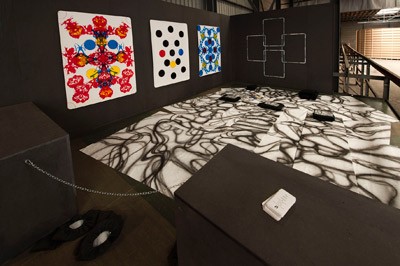ewoud van rijn
In his monumental drawings, Ewoud van Rijn (The Hague, 1967) has taken the ever-recurring discussion about the end of art and the death of painting and transformed it into a metaphor on the perpetual cycle of death and resurrection. This vision bleeds through in his transformations of exhibition spaces into places for ritual and encounter. In a mixture of text, drawings, sculpture and performance, Van Rijn explores the space where visual arts and esoteric thinking overlap in search of a new, meaningful positioning of the artist.
Ewoud van Rijn lives and works in Rotterdam. His work was previously displayed in Amsterdam, Rotterdam, The Hague, Tokyo and Los Angeles.
Mental journey
Don’t expect a ‘finished’ work of art, no painting, video installation or wood carved sculpture. The work of Ewoud van Rijn is in constant transition — there is no ‘finished’ whole, no end goal, everything may take a different shape along the way. And that ‘along the way’ — the journey, as buddhists call it — is more important than the destination.
That is why the presentation and working space Van Rijn (1967) built in the Noletloodsen, titled The White Dress, must be perceived as the result of a search for a new form of art practice. At its foundation lie three years of advanced experimental research into the relationship between contemporary art practices and spiritual practices. Experimental has in this case meant, for one, that Van Rijn, originally of a catholic upbringing, spent six months joining in the rituals of an Amsterdam-based devision of Wicca — one of the largest neopagan religions, enjoying a great following among witches in Denmark, Iceland, Australia and Great Britain. This and other contemporary ritual practices have been merged by Van Rijn and transformed into a ritual game, which the public can take part in.
During the ‘shamanistic journeys’ publicly organised by Van Rijn in the Noletloodsen, participants assume alternate identities through yoga exercises and a card game based on the Tarot. Once the transformation into that other person or being is realised, you, the participant, lie down on the floor and put on headphones. Rhythmical drums carry you from the Noletloodsen, across the industrial estate, over the top of Schiedam. Your brainwaves are now in a dream state. From that dream, a story emerges. Subsequently, Van Rijn hands out ‘recording cards’, onto which the aforementioned story is drawn. What did you see, hear, smell, feel? Those cards are hung up in the presentation and become part of The White Dress.
Meanwhile, Van Rijn will plan a trajectory for himself throughout Snapshot, during which he, through learnings of Swiss psychoanalyst Gustav Jung and shaman journeys, will arrive at his own ‘session cards’. These cards are based on the primary colours applied by Mondriaan in De Stijl. These colours, so Van Rijn explains, are also to be found in Tarot. They, to him, signify the beginning and the end. They symbolise life and death and the endless cycle between the two.


